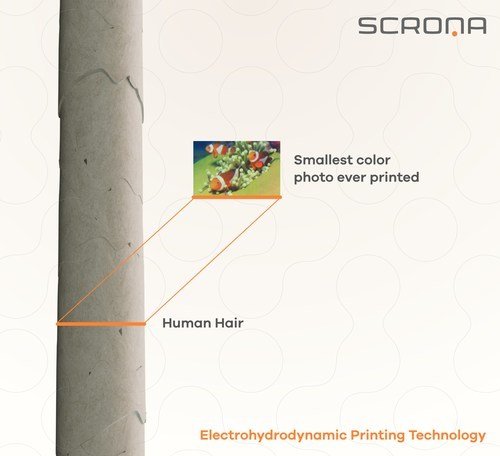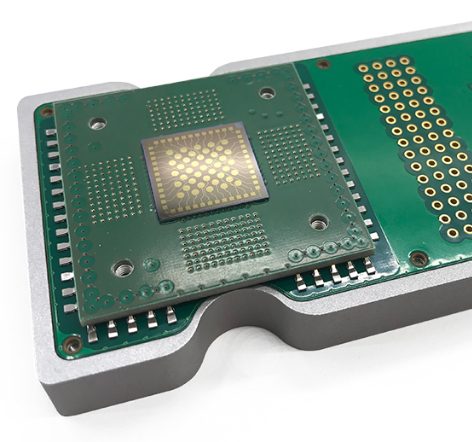Swiss startup Scrona AG has received $9.6 million in series A funding from AM Ventures, TRUMPF Venture and others, including the Swiss government. The infusion will aid the company in the commercialization and scaling of its potentially revolutionary electrostatic printhead technology. Capable of 3D printing multiple materials at sub-micron scales, the proprietary multi-nozzle technology could cut semiconductor backend circuit production from 22 steps to just one or two.
Scrona’s technology stands from inkjet 3D printing processes by combining high throughput with ultra-high resolution. Unlike other methods that print conductive materials at a scale of roughly 10 microns and standard inkjet processes that achieve around 50 micron resolution, Scrona’s technique is able to achieve 0.5 microns. And, unlike other, newer machines capable of depositing ink at similarly high resolutions, the Scrona printing technology is able to achieve high throughput on par with industrial 2D inkjet printers.
The key to the technology is avoiding the use of piezoelectric systems, the standard process by which inkjet heads work. HP, Xaar, Stratasys, and others rely on piezoelectricity inside the print nozzle to eject inks onto a substrate. This limits the viscosity, or flow, of the printing material to less than 50 cps (similar to motor oil) and the resolution of the droplets to somewhere in the range of 50 microns.
“Just imagine blowing liquid out of a very fine straw, That takes a lot of more pressure in your mouth basically than, than blowing liquid out of a very, uh, wide tube. So therefore in our process, we do it, I would say in a more elegant, in a more nature physics or in a, in a more nature science way. So we are using the liquid itself to stimulate ejection. So we don’t have anything, any element inside the printing anymore, but then really creating the force that is, that is pulling the liquid out in the liquid itself.
In contrast, Scrona has developed a proprietary method that generates an electric field just outside the tip of the nozzle. It attracts the liquid from the outside like a magnet, which makes the liquid pull out, forming a pointed cone pendant at the nozzle, ejecting and accelerating droplets only from the tip of the cone at a resolution of less than 0.5 microns. Not only are the droplets smaller than with standard piezoelectric printheads, but the material can be much more viscous at over 10,000 cps, roughly the flow of chocolate syrup.

Scrona has demonstrated the resolution capable with its technology by making the smallest color picture ever printed, which was even smaller than a human hair. Image courtesy of Scrona.
The ability to process higher viscosity inks opens up Scrona’s printing technology to a much wider variety of much more functional materials, including conductors, insulators, and semiconductors. And because the printhead can deposit multiple materials at once, this means combining all of the above materials into a single part within a single process. Printing them at high resolution makes it possible to achieve the quality necessary for the production of electronics, such as sensors, microelectromechanical systems (MEMS), and microchips. The startup demonstrated this possibility by producing test-circuits and is currently preparing demonstrators of complete components.

3D printed electronics produced using Scrona’s technology. Image courtesy of Scrona.
Theoretically, Scrona’s team believes that it is possible to reduce the 22 steps necessary to make the redistribution layers in an integrated circuit down to just one or two. Producing these layers typically requires applying photoiniatators to a substrate, oven baking, UV curing, electroplating, and much much more. With a Scrona print system, however, each of these layers could potentially be deposited within a single print job that features built-in annealing or UV curing.
While there are firms out there attempting to achieve this type of resolution for electronics production, the 3D printing industry may not be fully aware of them. These include Exaddon, Enjet, SIJ, and XLPL. Nonetheless, Scrona claims that they can not achieve the throughput required for mass production, which is where the Swiss startup is heading.
The company is currently producing the lab-scale Gen10 printhead for R&D units to explore the possibilities. In its next stage, Scrona will work with Notion-Systems to develop an industrial-quality Gen100 printhead over the next two years. By 2024, the startup wants to be collaborating with Tier 1 equipment manufacturers to commercialize its production-ready printheads in the high-end equipment of its partners for digital printing, semiconductor production, and displays.
Helping to drive this growth is the startup’s series A financing round, led by AM Ventures with syndicate partners including TRUMPF Venture, Verve Ventures and Manz GmbH Management Consulting and Investment. These groups contributed $6.7 million, while a grant from the Swiss Secretariat for Education, Research and Innovation (SERI) supplied $2.9 million more.
AM Ventures, which was launched by the Langer family behind 3D printing leader EOS, has a diverse array of 3D printing related firms in its portfolio. While they range from 3D printing at the small scale to using new materials and managing all parts of the additive manufacturing workflow, Scrona would seem to be its first electronics 3D printing firm. And, if it can deliver on its promises, it may not only put the Langers in the driver’s seat for the next industrial revolution, but Scrona could disrupt the way we make just about everything.
Subscribe to Our Email Newsletter
Stay up-to-date on all the latest news from the 3D printing industry and receive information and offers from third party vendors.
Print Services
Upload your 3D Models and get them printed quickly and efficiently.
You May Also Like
The Dental Additive Manufacturing Market Could Nearly Double by 2033, According to AM Research
According to an AM Research report from 2024, the medical device industry, specifically in dentistry, prosthetics, and audiology, is expected to see significant growth as these segments continue to benefit from...
Heating Up: 3D Systems’ Scott Green Discusses 3D Printing’s Potential in the Data Center Industry
The relentless rise of NVIDIA, the steadily increasing pledges of major private and public investments in national infrastructure projects around the world, and the general cultural obsession with AI have...
AM Research Webinar Explores Continuum’s Sustainable Metal Additive Manufacturing Powders
Metal additive manufacturing (AM) powder supplier Continuum Powders is working to develop solutions that empower industries to reduce waste and optimize their resources. An independent life cycle assessment (LCA) of...
3D Printed Footwear Startup Koobz Lands $7.2M in Seed Round
California-based Koobz is focused on reshoring the U.S. footwear supply chain with advanced manufacturing processes, including 3D printing. The startup just announced that it has added $6 million to its...
































